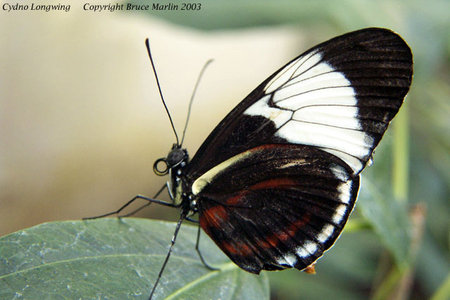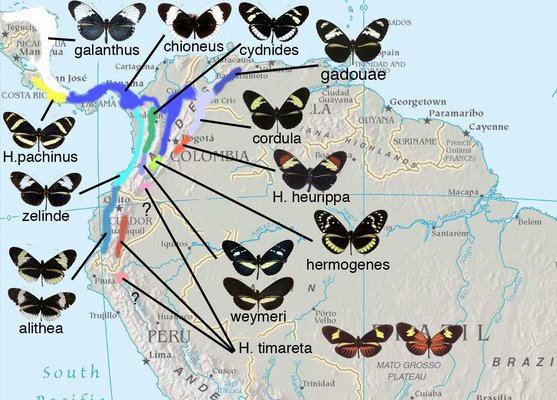Heliconius cydno
Margarita Beltrán and Andrew V. Z. BrowerIntroduction
Heliconius cydno is a polytypic species ranging from southern Mexico to western Ecuador, with a number of closely-related entities (including H. pachinus, H. heurippa, H. timareta and H. tristero) that have been described as separate species but may be differentiated geographical races or the results of introgressive hybridization. Patterns of gene flow between races of H. cydno and races of its close relative H. melpomene are the subject of much current research (e. g., Mavarez et al. 2006).
Heliconius cydno is involved in Müllerian mimicry with Heliconius sapho over most of its range, and also with Heliconius eleuchia in western Colombia and Ecuador. In the upper Cauca valley of Colombia, there are no corresponding races of either of the latter species, and H. cydno weymeri is comimetic with H. erato chestertonii, whose usual mimic H. melpomene is also not present there.
Characteristics
Early stages: Eggs are yellow and approximately 1.1 x 0.9 mm (h x w). Females usually place eggs singly on growing shoots and tendrils of the host plant. Early instar larvae have a white body and black spines. Mature larvae have a pinkish brown body with black spots, black scoli and the head is orange with two black horns; length is around 1.2 cm. Caterpillars are gregarious in small numbers. Pupae are dark brown with two rectangular gold patches on the thorax and have antennae with long spines, and long spines on the abdomen (Brown, 1981; DeVries, 1997).
Adult: Heliconius cydno butterflies are black with a variety of yellow or white bands or spots on forewings and/or hindwings. In general, regardless of the variation in the distribution and color of other wing pattern elements, adult specimens of H. cydno exhibit brown transverse bars on the ventral surface of the hindwings (as visible in the title photograph), a characteristic that easily distinguishes them from their mimics. Some hybrid specimens lack these bars, however. Forewing length: 38-43 mm.
Geographical Distribution
Heliconius cydno is distributed in Central America south to Venezuela, and Ecuador.

Habits
H. cydno occurs from sea level to 2,000 m in steep forests and gaps. Usually individuals fly rapidly and in the middlestory. Both sexes prefer red and orange flowers and collect large pollen loads from Psiguria plants. Females mate multiply and adults roost solitary at night at 2-10 m above ground on twigs or tendrils.
Hostplant: H. cydno is polyphagous and larvae feed primarily on plants from the subgenera Granadilla and Distephana (Passifloraceae). The secondary natural food plant is from the subgenus Astrophea and in laboratory or insectary experiments, larvae accept Tacsonia. In Costa Rica caterpillars of H. c. galanthus and H. c. chioneus feed on Passiflora vitifolia, P. biflora and most other Passiflora spp. (Passifloraceae) (DeVries, 1997).
Geographical Races
Like many species of Heliconius, H. cydno exhibits discrete geographical variation in its wing coloration, with relatively narrow zones of hybridization between adjacent geographical races. The following subspecific names are recognized by Lamas (2004):
- Heliconius cydno galanthus H. W. Bates 1864. southern Mexico to Costa Rica (Atlantic slope).
- Heliconius cydno chioneus H. W. Bates 1864. Eastern Costa Rica to northwestern Colombia.
- Heliconius cydno cydno Doubleday 1847. Magdalena Valley, Colombia.
- Heliconius cydno zelinde Butler 1869. Chocó, western Colombia.
- Heliconius cydno weymeri Staudinger 1897. Upper Cauca Valley, Colombia.
- Heliconius cydno hermogenes Hewitson [1858]. Central Magdalena Valley, Colombia.
- Heliconius cydno lisethae Neukirchen 1995. Upper Magdalena Valley, Colombia.
- Heliconius cydno wanningeri Neukirchen 1991. Santander, Colombia.
- Heliconius cydno cordula Neustetter 1913. Eastern Cordillera Oriental, Colombia.
- Heliconisu cydno cydnides Staudinger 1885. Sierra de Perija, Colombia.
- Heliconius cydno barinasensis Masters 1973. Cordillera Merida, Venezuela.
- Heliconius cydno gadouae K. S. Brown & F. Fernández 1985. Sierra de Perija, Venezuela.
- Heliconius cydno alithea Hewitson 1869. Pacific slope, Ecuador.
The following taxa are closely-elated to H. cydno and may represent geographical races/subspecies rather than distinct species (see Brower 1996):
- Heliconius pachinus Salvin 1871. Costa Rica (Pacific slope).
- Heliconius heurippa Hewitson [1854]. Meta, Colombia.
- Heliconius tristero Brower 1996. Putumayo, Colombia.
- Heliconius timareta timareta Hewitson 1867. Eastern Ecuador.
- Heliconius timareta timoratus Lamas 1998. Northeastern Peru.
References
Brower, A. V. Z. 1996 A new mimetic species of Heliconius (Lepidoptera: Nymphalidae), from southeastern Colombia, as revealed by cladistic analysis of mitochondrial DNA sequences. Zool. J. Linn. Soc. 116, 317-332.
Brown K. S. 1981 The Biology of Heliconius and Related Genera. Annual Review of Entomology 26, 427-456.
Brown, K. S., Jr. 1979 Ecologia Geográfica e Evolução nas Florestas Neotropicais. Campinas, São Paulo, Brasil: Universidade Estadual de Campinas.
DeVries P. J. 1997 The Butterflies of Costa Rica and Their Natural History, Volume I: Papilionidae, Pieridae, Nymphalidae Princeton University Press, Baskerville, USA.
Doubleday E. 1847 The genera of diurnal Lepidoptera: comprising their generic characters, a notice of their habits and transformations, and a catalogue of the species of each genus. London, Longman, Brown, Green & Longmans. 1: 87-98, pls. 16-17 (9 July 1847), 99-106, pls. 18-19 (4 August 1847), 107-110, pls. 18*, 20 (1 September 1847), 111-118, pls. 21, 23 (4 October 1847), 119-124, pls. 22, 24 (2 November 1847), 125-132, pls. 25, 28 (2 December 1847), 133-136 (7 January 1848), 137-138 (3 February 1848)
Lamas, G. (ed.) 2004 Atlas of Neotropical Lepidoptera. Checklist: Part 4A Hesperioidea - Papiionoidea. Gainesville: Scientific Publishers/Association of Tropical Lepidoptera.
Linares, M. 1997 Origin of neotropical mimetic biodiversity from a three-way hybrid zone of Heliconius cydno butterflies. In Tropcal biodiversity and systematics. Proceedings of the International Symposium on Biodiversity and Systematics in Tropical Ecosystems, Bonn, 1994. (ed. H. Ulrich), pp. 93-108. Bonn: Zoologisches Forschung Institut und Museum Alexander Koenig.
Mavarez, J., Salazar, C. A., Bermingham, E., Salcedo, C., Jiggins, C. D. & Linares, M. 2006 Speciation by hybridization in Heliconius butterflies. Nature 441, 868-871 , 11 supplementary pages.
Title Illustrations

| Scientific Name | Heliconius cydno |
|---|---|
| Location | Captive live butterfly photographed at Peggy Notebaert Nature Museum, Chicago, Illinois, USA |
| Comments | This captive specimen of Heliconius cydno chioneus Bates is a member of a geographical race occurring in Costa Rica and Panama. |
| Specimen Condition | Live Specimen |
| Image Use |
 This media file is licensed under the Creative Commons Attribution-NonCommercial-NoDerivs License - Version 2.5. This media file is licensed under the Creative Commons Attribution-NonCommercial-NoDerivs License - Version 2.5.
|
| Copyright |
© 2003 Bruce Marlin

|
About This Page

University of Cambridge, Cambridge, UK

Middle Tennessee State University, Murfreesboro, Tennessee, USA
Correspondence regarding this page should be directed to Margarita Beltrán at and Andrew V. Z. Brower at
Page copyright © 2010 and
 Page: Tree of Life
Heliconius cydno .
Authored by
Margarita Beltrán and Andrew V. Z. Brower.
The TEXT of this page is licensed under the
Creative Commons Attribution-NonCommercial-ShareAlike License - Version 3.0. Note that images and other media
featured on this page are each governed by their own license, and they may or may not be available
for reuse. Click on an image or a media link to access the media data window, which provides the
relevant licensing information. For the general terms and conditions of ToL material reuse and
redistribution, please see the Tree of Life Copyright
Policies.
Page: Tree of Life
Heliconius cydno .
Authored by
Margarita Beltrán and Andrew V. Z. Brower.
The TEXT of this page is licensed under the
Creative Commons Attribution-NonCommercial-ShareAlike License - Version 3.0. Note that images and other media
featured on this page are each governed by their own license, and they may or may not be available
for reuse. Click on an image or a media link to access the media data window, which provides the
relevant licensing information. For the general terms and conditions of ToL material reuse and
redistribution, please see the Tree of Life Copyright
Policies.
- First online 18 February 2007
- Content changed 04 September 2008
Citing this page:
Beltrán, Margarita and Andrew V. Z. Brower. 2008. Heliconius cydno . Version 04 September 2008. http://tolweb.org/Heliconius_cydno/72251/2008.09.04 in The Tree of Life Web Project, http://tolweb.org/










 Go to quick links
Go to quick search
Go to navigation for this section of the ToL site
Go to detailed links for the ToL site
Go to quick links
Go to quick search
Go to navigation for this section of the ToL site
Go to detailed links for the ToL site